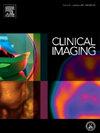常规胸部计算机断层扫描检测偶然冠状动脉钙化的预后价值:系统回顾和荟萃分析
IF 1.5
4区 医学
Q3 RADIOLOGY, NUCLEAR MEDICINE & MEDICAL IMAGING
引用次数: 0
摘要
背景:评估常规胸部计算机断层扫描(CT)发现的偶然冠状动脉钙化(CACi)在预测无症状个体心血管结局中的预后价值及其与他汀类药物处方的关系。方法检索MEDLINE/PubMed、EMBASE和Cochrane图书馆随机临床试验、前瞻性队列研究和回顾性队列研究。搜索词包括“CT”、“常规”、“胸腔”、“冠状动脉”和“钙化”的组合。主要结局是心血管死亡率和他汀类药物起始治疗的无症状患者在常规胸部CT上发现偶发CAC。采用R软件进行统计分析,具体版本为4.3.2。结果包括心血管死亡率和主要不良心血管事件(MACE)。次要结果包括每项研究报告的他汀类药物起始和药物依从性。结果7项研究共纳入67127例患者,其中4项为随机对照试验。随访时间为6至135个月,男性参与者的患病率为86%。结果显示,偶发CAC组心血管死亡的可能性明显更高(OR: 7.38, 95% CI: 4.10-13.28, p < 0.001)。异质性被认为是中等的,I2为45%,Chi2为7.26。结论在常规胸部ct上定量冠脉钙化是心血管危险分层的重要工具,冠脉钙化检测与心血管死亡风险相关,并增加心血管死亡风险。本文章由计算机程序翻译,如有差异,请以英文原文为准。
Prognostic value of incidental coronary artery calcium detected on routine chest computed tomography: A systematic review and meta-analysis
Background
To evaluate the prognostic value of incidental coronary artery calcium (CACi) identified on routine chest computed tomography (CT) scans in predicting cardiovascular outcomes and its association with statin prescription in asymptomatic individuals.
Methods
We searched MEDLINE/PubMed, EMBASE, and Cochrane Library for randomized clinical trials, prospective cohort studies, and retrospective cohort studies. Search terms included combinations of “CT,” “routine,” “thorax,” “coronary,” and “calcification. The primary outcomes were cardiovascular mortality and statin initiation in asymptomatic patients with incidental CAC detected on routine chest CT. Statistical analysis was performed using the R software, specifically version 4.3.2.Outcomes included cardiovascular mortality and major adverse cardiovascular events (MACE). Secondary outcomes included statin initiation and medication adherence as reported by each study.
Results
67,127 patients were included from 7 studies, of which 4 were RCT. Follow up ranged from 6 to 135 months and the prevalence of male participants was 86 %. The results indicated a significantly higher likelihood of cardiovascular mortality in the group with incidental CAC presence (OR: 7.38, 95 % CI: 4.10–13.28, p < 0.001). Heterogeneity was considered moderate, with an I2 of 45 % and a Chi2 of 7.26.
Conclusions
Incidental coronary artery calcium quantification on routine chest computed tomography is a valuable tool for cardiovascular risk stratification, and the detection of incidental coronary arterial calcium is related with and increased risk of cardiovascular mortality.
求助全文
通过发布文献求助,成功后即可免费获取论文全文。
去求助
来源期刊

Clinical Imaging
医学-核医学
CiteScore
4.60
自引率
0.00%
发文量
265
审稿时长
35 days
期刊介绍:
The mission of Clinical Imaging is to publish, in a timely manner, the very best radiology research from the United States and around the world with special attention to the impact of medical imaging on patient care. The journal''s publications cover all imaging modalities, radiology issues related to patients, policy and practice improvements, and clinically-oriented imaging physics and informatics. The journal is a valuable resource for practicing radiologists, radiologists-in-training and other clinicians with an interest in imaging. Papers are carefully peer-reviewed and selected by our experienced subject editors who are leading experts spanning the range of imaging sub-specialties, which include:
-Body Imaging-
Breast Imaging-
Cardiothoracic Imaging-
Imaging Physics and Informatics-
Molecular Imaging and Nuclear Medicine-
Musculoskeletal and Emergency Imaging-
Neuroradiology-
Practice, Policy & Education-
Pediatric Imaging-
Vascular and Interventional Radiology
 求助内容:
求助内容: 应助结果提醒方式:
应助结果提醒方式:


